Defining an audit scope specifies the areas to be examined for data security. It helps auditors and organizations understand what will be assessed and focus efforts effectively. Also, it ensures complete coverage of relevant aspects throughout the audit process.
In the audit process, the term \"scope\" refers to the wide range of components subject to evaluation. These components include data, information, software/tools, individuals, resources, and documents.
The audit scope defines how deep and wide the audit will go. It usually covers a company's main product, the data it handles, and the people, tools, and services involved.
In this article, we'll explore the details of audit scope and what it means for your business.
What Is Audit Scope?
Audit scope is a crucial part of auditing that sets boundaries for the audit. It specifies the areas, activities, processes, and time periods to be examined, ensuring a thorough and relevant audit. Understanding the audit scope is vital for auditors, stakeholders, and the audited entity as it establishes clear expectations and guides the entire audit process.
It involves defining the nature, type, and timing of audit procedures. A well-defined scope helps identify risks and issues within an organization, focusing on areas where risks are most likely to occur. This targeted approach ensures the audit is efficient and effective in highlighting critical areas needing attention.
The scope also includes the subject matter and criteria auditors use to evaluate and report on it, directly aligning with objectives. It outlines the procedures for gathering audit evidence and ensuring a comprehensive evaluation.
Audit Scope Examples
- For SOC 2 audits, the scope is primarily defined by customer data. This includes any tools or software platforms where customer data is stored, processed, or transmitted. Additionally, any personnel with access to customer data are also within the scope of the audit.
- For ISO audits, an organization-wide scope is preferable whenever feasible. It's not mandatory to delineate every component within an Information Security Management System (ISMS). Instead, the scope encompasses all individuals, processes, and technologies involved in delivering the organization's services or products.
- For GDPR compliance audits, the scope typically revolves around personal data handling practices. This includes all systems, processes, and personnel involved in collecting, processing, and storing personal data of EU citizens. Additionally, third-party vendors or partners with access to this data may fall within the audit scope.
- The scope of HIPAA audits focuses on protecting patient health information (PHI). This encompasses all electronic systems, physical facilities, and administrative procedures that handle PHI. Healthcare professionals, business associates, and any other entities involved in PHI transmission or storage are included within the audit scope.
Key Components Of Audit Scope
By clearly defining the audit scope, auditors and stakeholders can ensure the audit is focused, efficient, and aligned with the organization’s objectives. Below are some key components to include in your audit scope.
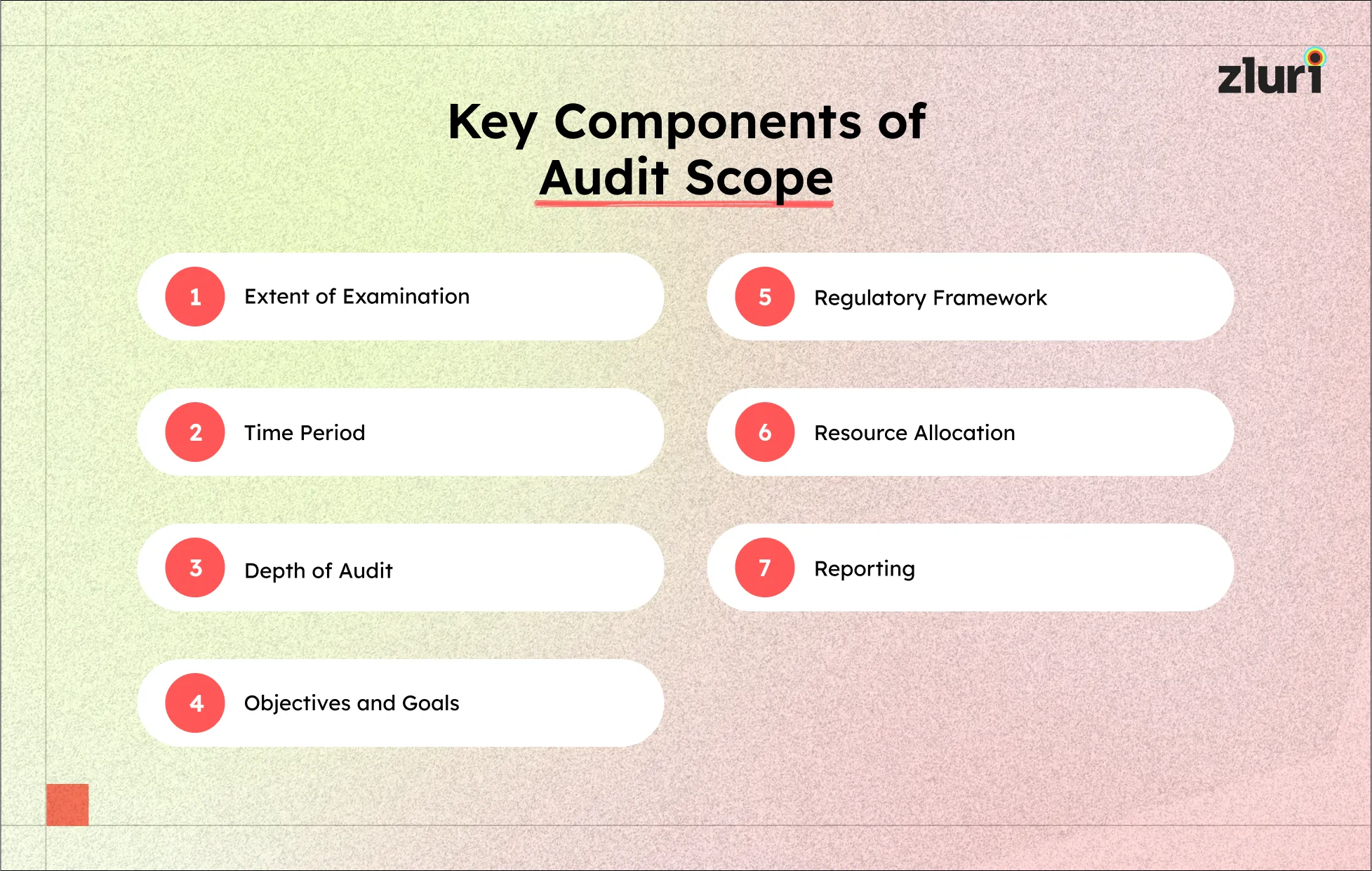
1: Extent of Examination
The extent of examination specifies which departments, functions, or processes within the organization will be included in the audit. This could range from financial operations and IT security to HR practices and compliance procedures. Defining this clearly ensures that the audit covers all relevant areas while excluding those that are out of scope, thereby maintaining a focused approach.
2: Time Period
The time period identifies the specific duration or financial year(s) the audit will cover. This could be a particular fiscal period, quarter, or any other defined timeframe. Establishing the time period is crucial for analyzing trends, comparing performance across different periods, and ensuring the audit remains relevant and up-to-date.
3: Depth of Audit
The depth of the audit determines how thoroughly each area will be examined. This could range from a high-level overview to a detailed examination of specific processes. Deciding on the depth helps allocate resources effectively and ensure that critical areas receive the necessary attention.
4: Objectives and Goals
Outlining the audit's objectives and goals is essential. This component specifies what the audit aims to achieve, such as verifying compliance, ensuring financial accuracy, or assessing process effectiveness. Clear objectives guide the audit process and set the stage for potential recommendations, improvements, or corrective actions that may follow the audit.
5: Regulatory Framework
Including the regulatory framework in the audit scope involves identifying any specific laws, standards, policies, procedures, or regulations that the audit will assess compliance with. This ensures that the audit remains relevant to external requirements and internal policies, helping the organization stay compliant and avoid legal or regulatory issues.
6: Resource Allocation
Resource allocation details the manpower, technology, documentation, and data that will be dedicated to the audit. Clearly defining resource allocation ensures that the audit team has the necessary tools and support to perform their duties effectively, leading to a more efficient and thorough audit process.
7: Reporting
The reporting component defines what content will be included in the audit results, how the findings will be reported and formatted, and to whom the results will be delivered. Establishing clear reporting guidelines ensures stakeholders receive relevant, understandable, and actionable insights from the audit, facilitating informed decision-making and strategic planning.
By considering these key components, auditors can ensure their efforts align with the organization's goals and compliance requirements. A well-defined audit scope enhances the audit's effectiveness and contributes to the organization's overall governance and risk management framework.
Why Is Audit Scope Important?
The importance of scope in auditing cannot be overstated, as it essentially sets the parameters for what the auditor can investigate, inquire about, and analyze. By defining the scope, organizations delineate what aspects of their operations, processes, and systems are subject to scrutiny. This clarity is crucial for both the auditing entity and the organization being audited.
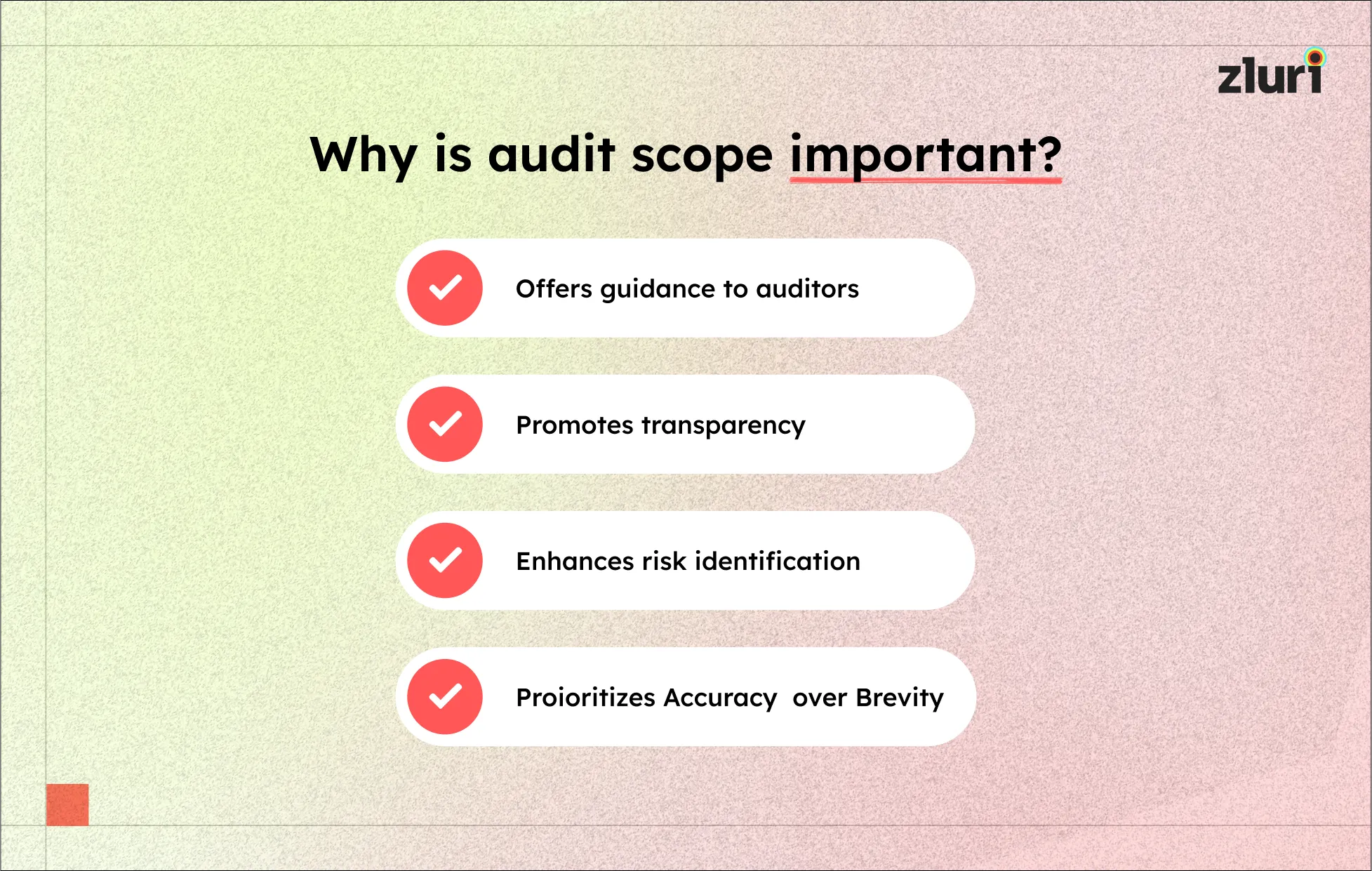
- It offers guidance to auditors
Firstly, the scope serves as a guide for auditors, directing their attention to specific areas pertinent to the audit's objectives. Without a clear scope, auditors may lack direction and inadvertently overlook crucial elements or delve into irrelevant details. Therefore, a well-defined scope ensures that auditors focus their efforts on assessing the most relevant aspects of the organization's operations.
- It promotes transparency
Secondly, the scope provides transparency and clarity to the organization under audit. It outlines the boundaries of the audit process, clarifying which areas will be examined and which will not. This transparency fosters trust between the auditing entity and the organization being audited, ensuring that the audit process is conducted fairly and objectively.
- It enhances risk identification
Moreover, a comprehensive scope enables auditors to identify and address potential risks and vulnerabilities more effectively. By encompassing all relevant components of the organization's operations, the scope allows auditors to thoroughly assess its internal controls, processes, and procedures. This, in turn, helps identify weaknesses or deficiencies that may pose risks to the organization's objectives, assets, or reputation.
- It prioritizes accuracy over conciseness
While there may be a temptation to limit the scope of an audit to reduce the burden of providing evidence and documentation, it is essential to prioritize accuracy over brevity. A narrow scope may overlook critical areas of concern or fail to uncover potential risks, undermining the effectiveness of the audit process. Therefore, organizations should ensure that the scope is comprehensive and aligned with the objectives of the audit, even if it means a greater workload in terms of evidence requests and data analysis.
In summary, scope is important in auditing because it can guide the process, promote transparency, and facilitate the identification of risks and vulnerabilities. By defining the boundaries of the audit and focusing attention on relevant areas, scope ensures that the audit is conducted thoroughly and objectively, ultimately contributing to the organization's overall governance, risk management, and compliance efforts.
How Is Audit Scope Determined?
Several key factors should be considered when determining the scope of an audit to ensure a comprehensive and effective audit process. The audit scope defines the boundaries and focus areas of the audit, guiding the auditors on what to review, analyze, and evaluate.
Here are some key steps to determine the audit scope:-
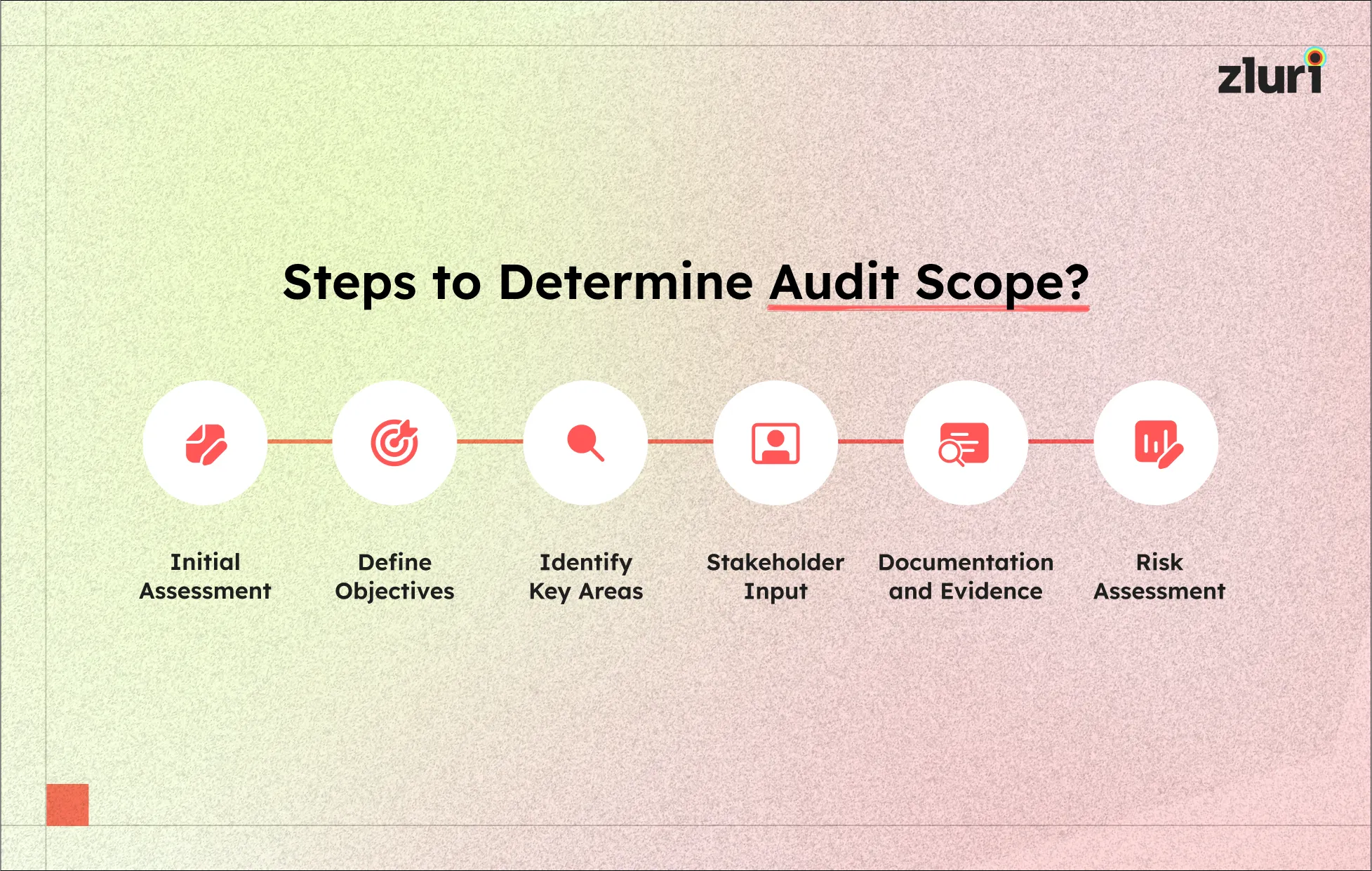
Initial Assessment
The audit scope is primarily determined by whoever is leading the compliance and readiness efforts for a company or customer. This person or team will conduct an initial assessment to identify the areas that need to be audited. The assessment considers various factors, including the organization's compliance requirements, industry standards, and specific risks associated with the business processes.
Define Objectives
Clearly defining the audit objectives is crucial. The audit scope should align with the audit goals, such as ensuring regulatory compliance, evaluating the effectiveness of internal controls, identifying potential risks, or verifying the accuracy of financial statements.
Identify Key Areas
Key areas that typically fall within the audit scope include financial records, operational processes, IT systems, security controls, and compliance with relevant laws and regulations. Each of these areas should be reviewed to ensure they meet the necessary standards and are functioning as intended.
Stakeholder Input
Input from various stakeholders, including management, IT, compliance officers, and department heads, is essential in determining the scope. These stakeholders provide insights into potential risks and areas of concern that should be included in the audit.
Documentation and Evidence
Proper documentation is critical for a successful audit. Identifying the documents and evidence that will be reviewed during the audit helps define the scope. This includes policies, procedures, transaction records, and system logs.
Risk Assessment
Conducting a risk assessment helps prioritize the areas that pose the highest risk to the organization. This ensures that the audit focuses on critical areas that could significantly impact the business if not properly managed.
Setting the audit scope is essential for identifying potential risks, ensuring compliance with regulations, and improving overall organizational performance. By considering the given factors, organizations can establish a clear and actionable audit scope that aligns with their objectives and regulatory requirements.
Who Should Be Included In The Audit Scope?
Determining who should be included in the audit scope is crucial in ensuring a comprehensive and effective audit. Including the right personnel is essential for accurately assessing compliance, operational effectiveness, and risk management.
Here’s a detailed breakdown of the different roles and groups that should be included in the audit scope:
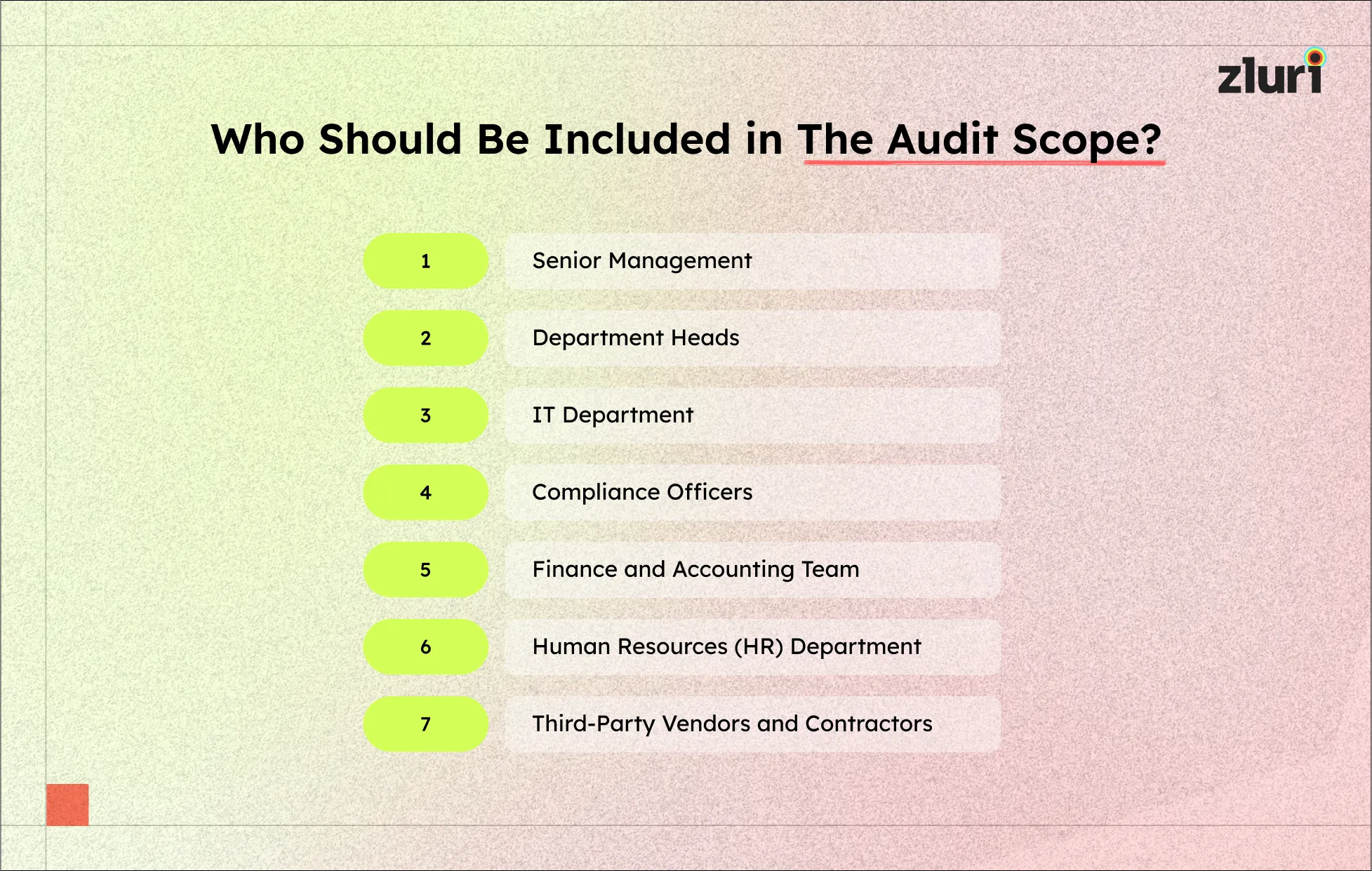
1. Senior Management
Senior management is pivotal in shaping an organization's strategic direction and policies. Including them in the audit scope ensures:
- Policy Oversight: Senior management is responsible for formulating and overseeing the organization's policies. Auditing their involvement helps evaluate these policies' alignment with regulatory and compliance standards.
- Strategic Decisions: They often significantly affect risk management, financial health, and operational efficiency. Assessing these decisions provides insight into the overall governance and strategic risk management practices.
2. Department Heads
Department heads oversee the day-to-day operations within their respective areas. Including them ensures:
- Operational Compliance: Each department head is accountable for ensuring their department adheres to internal policies and regulations. Auditing their role helps in verifying departmental compliance.
- Process Management: They are responsible for managing key processes within their departments. Auditing these processes helps identify any procedural inefficiencies or non-compliances.
3. IT Department
IT teams are crucial for maintaining the technological infrastructure and ensuring data security. Including them ensures:
- System Security: IT staff manage and secure the organization's IT systems. Auditing their activities helps assess the effectiveness of cybersecurity measures and compliance with IT policies.
- Data Management: They are responsible for data management, including its storage, transmission, and protection. Auditing their role helps verify the integrity and security of data management practices.
4. Compliance Officers
Compliance officers ensure the organization adheres to relevant laws, regulations, and internal policies. Including them ensures:
- Regulatory Adherence: They monitor compliance with external regulations and internal policies. Auditing their activities helps in verifying the organization's compliance status.
- Risk Management: Compliance officers often identify and mitigate compliance risks. Auditing their role helps in evaluating the effectiveness of risk management practices.
5. Finance and Accounting Team
Finance and accounting staff manage the organization's financial records and transactions. Including them ensures:
- Financial Accuracy: They maintain accurate financial records and ensure proper financial reporting. Auditing their activities helps in verifying the accuracy and integrity of financial information.
- Fraud Detection: Their role is critical in detecting and preventing financial fraud. Auditing their activities helps in assessing the effectiveness of anti-fraud measures.
6. Human Resources (HR) Department
HR personnel manage employee-related processes, including recruitment, training, and compliance with labor laws. Including them ensures:
- Employee Compliance: They ensure that employees comply with internal policies and procedures. Auditing their role helps in verifying adherence to HR policies and regulations.
- Training and Development: HR is responsible for employee training and development programs. Auditing these programs helps assess their effectiveness in promoting compliance and operational efficiency.
7. Third-Party Vendors and Contractors
Third-party vendors and contractors often have access to the organization's systems and data. Including them ensures:
- Vendor Compliance: Vendors must comply with the organization's security and operational standards. Auditing their activities helps verify their compliance with these standards.
- Risk Mitigation: Third-party relationships can introduce additional risks. Auditing these relationships helps assess and mitigate third-party risks.
Including the right personnel in the audit scope is essential for conducting a thorough and effective audit. This thorough approach ensures that all relevant aspects of the organization are evaluated, leading to more accurate and actionable audit findings.
Key Factors Influencing Audit Scope
When determining the scope of an audit, several key factors come into play, each influencing the breadth and depth of the examination:
- Audit Objectives: Clearly defined audit objectives are paramount. Whether it's ensuring compliance with regulations, evaluating internal controls, verifying financial statements, or pinpointing areas for improvement, these objectives shape the scope.
- Risk Assessment: Conducting a thorough risk assessment is crucial. Identifying high-risk areas or processes helps prioritize them within the scope, ensuring they receive adequate scrutiny.
- Regulatory and Legal Requirements: Specific industries or sectors may have unique regulatory or legal obligations. Auditors must ensure that the scope aligns with these requirements to maintain compliance.
- Stakeholder Expectations: It is vital to consider key stakeholders' expectations. Input from management, board members, or external regulators helps tailor the scope to address their concerns and priorities.
- Available Resources: The scope must be realistic given available resources such as time, budget, and auditor expertise. Overscoping can lead to inefficiencies and delays.
- Materiality and Significance: Auditors should weigh the materiality and significance of different areas or processes. Those with higher materiality or significance may warrant more extensive examination within the scope.
- Previous Audit Findings: Insights from past audits are invaluable. They guide auditors in identifying areas requiring follow-up or additional scrutiny in the current audit, ensuring a comprehensive review of critical aspects.
Benefits of a Well-Defined Audit Scope in Identifying Risks
A well-defined audit scope plays a pivotal role in identifying potential risks and issues within an organization, offering several significant benefits:
- Targeted Risk Assessment: A well-defined scope clearly delineates the boundaries of the audit, allowing for targeted risk assessment. Auditors can focus their efforts on specific areas where risks are most likely to be present, ensuring a thorough examination of critical aspects.
- Optimal Resource Allocation: Clarity in the audit scope facilitates optimal resource allocation. Efforts and resources can be directed to high-risk areas, maximizing the effectiveness of the audit process while avoiding unnecessary expenditures in low-risk areas.
- Alignment with Relevant Risk Areas: A clear audit scope ensures alignment with the organization's most relevant risk areas. The audit can effectively assess and mitigate risks by focusing on these critical issues, enhancing overall risk management practices.
- Early Detection of Issues: Early detection of issues is crucial in risk mitigation. A focused audit scope helps identify problems at an early stage, enabling prompt corrective actions. This proactive approach prevents minor issues from escalating into major problems, ultimately saving time and resources.
- Comprehensive Coverage: The audit can comprehensively cover all critical organizational areas with a well-defined scope. This ensures that no risk goes unnoticed, as the examination is thorough and systematic, leaving no stone unturned.
Thus, a well-defined audit scope facilitates targeted risk assessment and optimal resource allocation, ensures alignment with relevant risk areas, enables early issue detection, and offers comprehensive coverage. These benefits collectively enhance the effectiveness of the audit process and contribute to robust risk management practices within the organization.
Does the Audit Scope Differ Across Various Industries or Organizations?
The scope of an audit can indeed vary significantly across different industries and organizations due to several factors:
- Industry-Specific Requirements: Each industry has its own set of regulatory and compliance standards. These industry-specific requirements directly influence the audit scope, with auditors tailoring their approach to address sector-specific regulations and best practices.
- Organizational Size and Complexity: An organization's size and complexity play a crucial role in determining its audit scope. Larger or more intricate organizations typically require a broader and more detailed scope to assess their operations and controls adequately.
- Nature of Business Activities: The nature of an organization's business activities also impacts the audit scope. For instance, manufacturing companies may have different focus areas compared to service-based businesses, leading to variations in the scope of the audit.
- Risk Profile: Organizations have varying levels of risk exposure across different areas, including financial, operational, and technological risks. The audit scope is tailored to address each organization's specific risk profile, with a focus on mitigating potential threats and vulnerabilities.
- Previous Audit Findings: Past audit findings can influence the focus of future audits. If previous audits uncovered specific areas of concern or areas requiring improvement, the scope of subsequent audits may be adjusted to prioritize these issues and ensure appropriate follow-up actions are taken.
In summary, the scope of an audit can vary significantly across industries and organizations, depending on industry-specific requirements, organizational size and complexity, the nature of business activities, risk profile, and previous audit findings. Auditors must carefully consider these factors to tailor the audit scope effectively and address each client's unique needs and circumstances.
Audit Scope: Defining the Path to Audit Success
Determining the scope of an audit is a pivotal step that lays the groundwork for a fruitful and impactful audit engagement. An effective audit scope hinges on a comprehensive grasp of the organization's operations, regulatory landscape, and areas of concern. It also demands active stakeholder engagement, ongoing risk assessment, and a readiness to adapt the scope as necessary throughout the audit journey.
By carefully considering key factors, following the best methods, and using the right tools, auditors can create a scope that matches the organization's goals, manages risks, and meets stakeholders' expectations. For instance, consider integrating dedicated compliance software to enhance your audit readiness. Having said that, you can opt for Zluri, which simplifies user access review, a critical aspect of compliance management. With Zluri, you gain swift access assessment and comprehensive visibility into users, roles, and access patterns across all applications.
Zluri also simplifies access remediation by automating the identification and rectification of overprivileged access instances. This improves security by swiftly adjusting access permissions during the review process. Zluri's automated access risk identification also helps your company defend itself against potential threats.
Furthermore, Zluri simplifies tasks such as gathering access-related data, organizing access levels, and examining access patterns. Automating these processes ensures your organization's peace of mind, compliance, and enhanced security.









.svg)



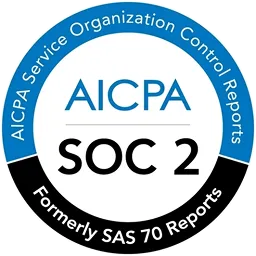
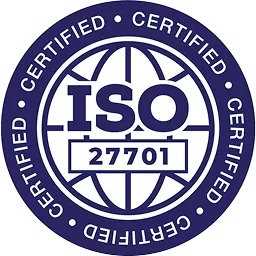
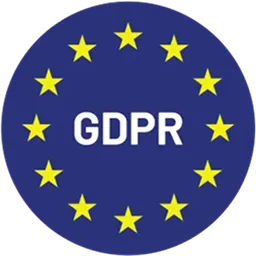
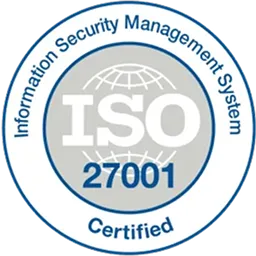
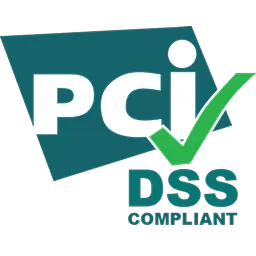
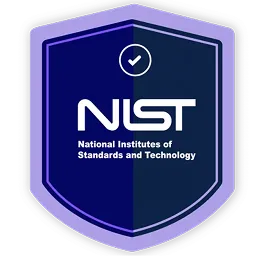
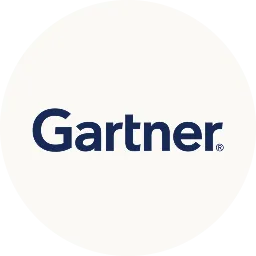
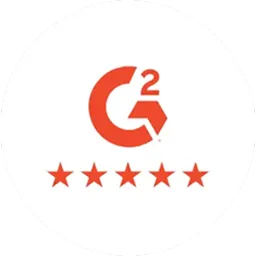

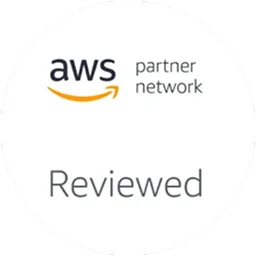

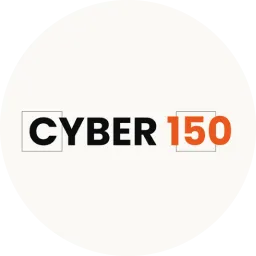






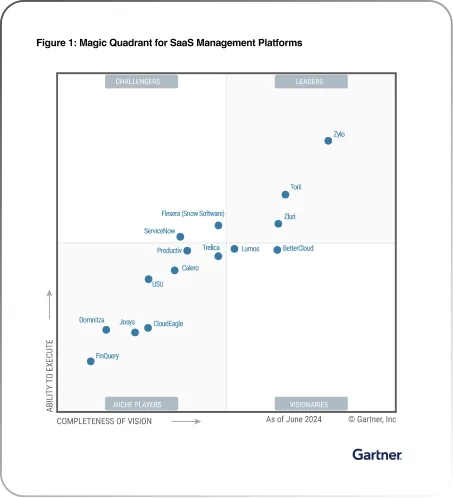







.webp)







.webp)
.webp)





.webp)